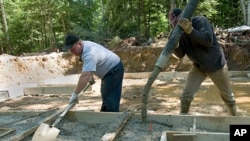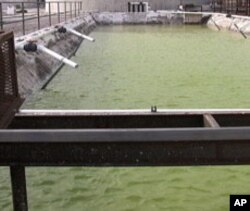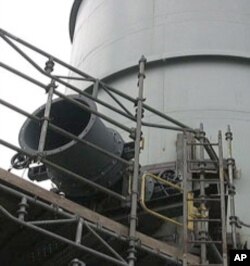Cement is a major component of concrete, the world's most widely used man-made material, an integral part of roads, bridges and buildings. But making cement requires heating limestone and other materials to very high temperatures, a process that releases into the atmosphere large amount of carbon dioxide, or CO2, a leading cause of global warming.
Brent Constantz is working to fix that problem with an environmentally-friendly cement that actually captures CO2 and locks it away.
A clean approach to making a dirty product
At his California company, Calera, scientists mix air and water to create the cement powder and aggregate pebbles that are the basic ingredients of concrete. But while traditional cement, called Portland cement, adds CO2 to the atmosphere, Calera's green cement takes the greenhouse gas out of the air - a lot of it. For every unit of carbon that Portland cement adds to the air, Brent Constantz says his green cement removes three units. "The more concrete you pour, the more CO2 you take out of the environment. So the way to mitigate the carbon problem is to pour more concrete!" But only, Constantz adds, if it's his concrete.
Conventional cement is the world's third-largest industrial contributor of CO2, mainly due to the high-temperature kilns required to make traditional cement pastes. Calera produces cement without high heat. Constantz explains the patented process mimics the way that nature grows the hard, durable materials in teeth, bone and sea shells. "It's a complicated, interesting, beautiful biologic process," he says, "that produces fantastic structures like a chambered nautilus shell or the human hip and the greater trochanter in the top of our femur, which are elaborate biologic structures made out of mineral."
Calera's technology targets the CO2 in the smoky air that's belched from the smokestacks of large industrial sites, such as coal-fired power plants. To capture the gas, Calera mixes the air with briny, brackish seawater, oil field wastewater or other salty waters. This causes minerals in the water to bond with CO2 and then rain out as particles of synthetic limestone. As a bonus, the briny water becomes easier to turn into drinkable water.
Proving its process in the real world
Calera's been doing all this in its labs. Now, it's gearing up to do it on a grander scale, near California's largest power plant, at Moss Landing, on the Pacific coast near San Francisco. Giant turbines at the Dynegy company's gas-fired plant generate electric power for roughly 2 million people.
In January, Calera began drawing one percent of the Dynegy stack gas through a massive pipe, across the street to its green cement plant. Calera hopes to capture 80 percent of the smokestack CO2, and sequester it in its patented cement mixture. If it works, says Moss Landing Power Plant manager Jim Dodson, the technology could be a game-changer for carbon sequestration efforts. He calls the Calera process "probably one of the best carbon-capture processes out there that we know of today."
Conventional carbon-capture technologies, such as chemical scrubbing, can capture as much as 90 percent of the CO2 from smokestack gas. However, they also use a lot of the energy generated by the plant, almost doubling the cost of the power for consumers.
The U.S. Department of Energy is looking for new carbon-capture technologies that can reduce this so-called parasitic load on power production below 30 percent. Calera's Brent Constantz says his company's relatively low-cost cement-making process can surpass that, cutting a plant's energy drain in half, to less than 15 percent. And he says adding in the potential profits from Calera's green cement would completely offset the financial loss of reduced power plant output. "Our costs of goods are lower than Portland cement because we don't have to burn coal or build a quarry and quarry limestone," he explains, "so our capital costs are quite a bit lower." He estimates using Calera's technology would effectively cut the parasitic load to zero.
Next step: convincing the concrete industry
But many experts in the traditional concrete industry - like Steve Regis of Cal-Portland Cement - are skeptical that Calera can make an affordable cement. "I simply don't believe it, and I've seen no evidence otherwise," he says.
While he doubts many of Calera's claims, Regis says he wants more carbon capture, and the concrete industry is eager to inspect Calera's products. "We can run tests that look at how hard it is, how durable it is, we can look at all that then run several tests out in less than 6 months." Brent Constantz says his products have already passed those tests, and he promises that the company will share that information when the time is right.
Constantz hopes that traditional concrete makers will team up, first, by blending Calera's green cement product with traditional Portland cement. The goal will be to fight global warming by capturing carbon in concrete . . . so much that it would help reverse man-made climate change.
"We can actively sequester about 16 billion tons of CO2 a year in a profitable, sustainable, ongoing way for our children, our great grandchildren, for centuries to come and deal literally with most of the carbon problem," he insists. The key, he says, is to start tackling that problem – right now.











